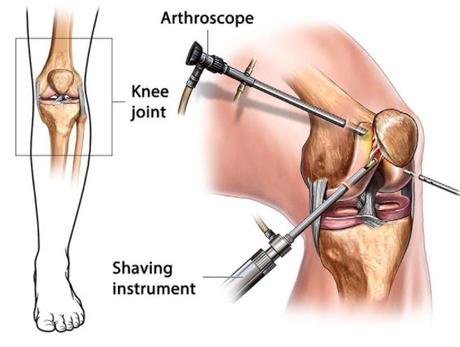In this article, Dr Dilip Mehta, one of the best orthopaedic doctors in Jaipur talks about “What is Knee Arthroscopy and what is the treatment for it?”
Dr Dilip Mehta has been practicing in Jaipur with vast experience in the field of joint replacement and arthroscopy.
He is probably to the few doctors who have been equally trained in both the super speciality field of joint replacement and arthroscopy which are high-level precision demanding surgeries.
He is probably the only Indian who had been lucky enough to work with the world’s best shoulder surgeon Dr Burkhart at SAOG, Texas USA.
Knee arthroscopy is a surgical treatment that allows surgeons to see into the knee joint without creating a big incision through the skin and other soft tissues.
Knee arthroscopy is a surgical treatment that allows surgeons to see into the knee joint without creating a big incision through the skin and other soft tissues. Arthroscopy is a procedure that is used to diagnose and treat a wide variety of knee conditions.
Knee arthroscopy is a procedure in which your surgeon inserts a small camera into your knee joint, known as an arthroscope. On a video monitor, images from the camera are displayed, and your surgeon utilises these images to guide miniature surgical instruments during the procedure.
A little incision can be made instead of a bigger incision than would be required for open surgery because of the thinness of both the arthroscope and the surgical tools used in it.
The upshot is that patients experience less pain and less joint stiffness, and the time it takes for them to heal and return to their favorite hobbies is generally shorter.
When is Knee arthroscopy recommended?
Jaipur based Dr Dilip Mehta a leading orthopedist says that A knee arthroscopy may be recommended by your doctor if you are suffering from a painful ailment that is not responding to nonsurgical treatment. Rest, physical therapy, and drugs or injections that can lower inflammation are all options for nonsurgical treatment.
When performed on the knee, an arthroscopy may be effective in alleviating the painful symptoms associated with a variety of disorders that affect the cartilage surfaces and other soft tissues around the joint.
The following are examples of common arthroscopic surgeries for the knee:
- A torn meniscus can be repaired or removed
- Damaged articular cartilage is being trimmed
- Debris of bone or cartilage is removed during this procedure
- Patella (kneecap) issues are treated in the same way
- Knee sepsis is treated with antibiotics (infection)

Surgical Methods and Techniques
Positioning
Anaesthesia will be administered to you once you have been taken into the operation room. The skin on your knee will be cleansed in order to reduce the risk of surgical site infection. Your leg will be draped with surgical draping, which will reveal the incision site that has been prepped.
An arthroscopic operation is performed on the knee, and a positioning device is sometimes placed on the leg to assist in stabilising the knee throughout the surgery.
Procedure
In order to begin the treatment, the surgeon will make a series of small incisions in your knee, which are referred to as “portals.”
A sterile solution will be used to fill the knee joint and flush out any murky fluid that may have accumulated. This enables your orthopedic surgeon to see the components inside your knee clearly and in great detail, which is beneficial for your recovery.
The first task for your surgeon is to accurately diagnose the nature of your condition. Inserting the arthroscope and using the image presented on the screen he or she will be guiding it. If surgical intervention is required, your surgeon will put tiny instruments via other small incisions to do the procedure.
Shaving, cutting, gripping, and meniscal healing are all procedures that require the use of specialised instrumentation. When it comes to securing stitches into bone, specific devices are frequently employed notes Dr Dilip Mehta a premium orthopedist from Jaipur.
Closure
Arthroscopic incisions are covered with a closure bandage. Your incisions will be protected while they heal with a comfortable bandage.
The majority of knee arthroscopy treatments are completed in less than an hour. The length of the procedure will be determined by the findings and the amount of treatment required.
Your surgeon may close each incision with a stitch or sterile strips (tiny bandaids), after which he or she will wrap your knee in a comfortable bandage to prevent further bleeding.
Complications
The rate of complications following arthroscopic surgery is extremely low. If issues do arise, they are usually mild and may be dealt with quickly and easily. The following are examples of potential postoperative complications associated with knee arthroscopy:
- Infection
- Thrombosis is a type of blood clot
- Stiffness in the knees
- Blood clots forming in the knee joint

Recovery
Once you have been transferred to the recovery room, you should be able to return home within one or two hours. It is essential that you have someone with you who will drive you home and check on you on the first evening after arriving.
While recovery after knee arthroscopy is quicker than recovery from standard open knee surgery, it is still crucial to carefully follow your doctor’s recommendations once you have returned home from the hospital notes Dr Dilip Mehta a top orthopedist who hails from Jaipur.
**SP**
